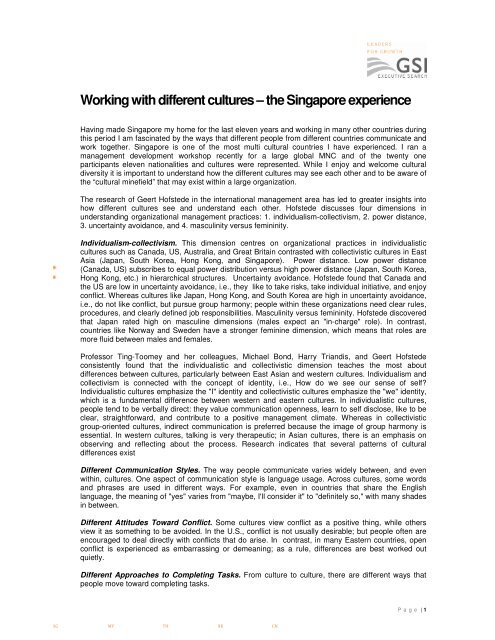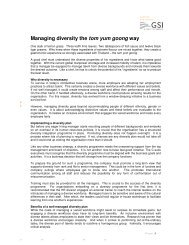Working with different cultures – the Singapore experience
Working with different cultures – the Singapore experience
Working with different cultures – the Singapore experience
Create successful ePaper yourself
Turn your PDF publications into a flip-book with our unique Google optimized e-Paper software.
<strong>Working</strong> <strong>with</strong> <strong>different</strong> <strong>cultures</strong> <strong>–</strong> <strong>the</strong> <strong>Singapore</strong> <strong>experience</strong><br />
Having made <strong>Singapore</strong> my home for <strong>the</strong> last eleven years and working in many o<strong>the</strong>r countries during<br />
this period I am fascinated by <strong>the</strong> ways that <strong>different</strong> people from <strong>different</strong> countries communicate and<br />
work toge<strong>the</strong>r. <strong>Singapore</strong> is one of <strong>the</strong> most multi cultural countries I have <strong>experience</strong>d. I ran a<br />
management development workshop recently for a large global MNC and of <strong>the</strong> twenty one<br />
participants eleven nationalities and <strong>cultures</strong> were represented. While I enjoy and welcome cultural<br />
diversity it is important to understand how <strong>the</strong> <strong>different</strong> <strong>cultures</strong> may see each o<strong>the</strong>r and to be aware of<br />
<strong>the</strong> “cultural minefield” that may exist <strong>with</strong>in a large organization.<br />
The research of Geert Hofstede in <strong>the</strong> international management area has led to greater insights into<br />
how <strong>different</strong> <strong>cultures</strong> see and understand each o<strong>the</strong>r. Hofstede discusses four dimensions in<br />
understanding organizational management practices: 1. individualism-collectivism, 2. power distance,<br />
3. uncertainty avoidance, and 4. masculinity versus femininity.<br />
Individualism-collectivism. This dimension centres on organizational practices in individualistic<br />
<strong>cultures</strong> such as Canada, US, Australia, and Great Britain contrasted <strong>with</strong> collectivistic <strong>cultures</strong> in East<br />
Asia (Japan, South Korea, Hong Kong, and <strong>Singapore</strong>). Power distance. Low power distance<br />
(Canada, US) subscribes to equal power distribution versus high power distance (Japan, South Korea,<br />
Hong Kong, etc.) in hierarchical structures. Uncertainty avoidance. Hofstede found that Canada and<br />
<strong>the</strong> US are low in uncertainty avoidance, i.e., <strong>the</strong>y like to take risks, take individual initiative, and enjoy<br />
conflict. Whereas <strong>cultures</strong> like Japan, Hong Kong, and South Korea are high in uncertainty avoidance,<br />
i.e., do not like conflict, but pursue group harmony; people <strong>with</strong>in <strong>the</strong>se organizations need clear rules,<br />
procedures, and clearly defined job responsibilities. Masculinity versus femininity. Hofstede discovered<br />
that Japan rated high on masculine dimensions (males expect an "in-charge" role). In contrast,<br />
countries like Norway and Sweden have a stronger feminine dimension, which means that roles are<br />
more fluid between males and females.<br />
Professor Ting-Toomey and her colleagues, Michael Bond, Harry Triandis, and Geert Hofstede<br />
consistently found that <strong>the</strong> individualistic and collectivistic dimension teaches <strong>the</strong> most about<br />
differences between <strong>cultures</strong>, particularly between East Asian and western <strong>cultures</strong>. Individualism and<br />
collectivism is connected <strong>with</strong> <strong>the</strong> concept of identity, i.e., How do we see our sense of self<br />
Individualistic <strong>cultures</strong> emphasize <strong>the</strong> "I" identity and collectivistic <strong>cultures</strong> emphasize <strong>the</strong> "we" identity,<br />
which is a fundamental difference between western and eastern <strong>cultures</strong>. In individualistic <strong>cultures</strong>,<br />
people tend to be verbally direct: <strong>the</strong>y value communication openness, learn to self disclose, like to be<br />
clear, straightforward, and contribute to a positive management climate. Whereas in collectivistic<br />
group-oriented <strong>cultures</strong>, indirect communication is preferred because <strong>the</strong> image of group harmony is<br />
essential. In western <strong>cultures</strong>, talking is very <strong>the</strong>rapeutic; in Asian <strong>cultures</strong>, <strong>the</strong>re is an emphasis on<br />
observing and reflecting about <strong>the</strong> process. Research indicates that several patterns of cultural<br />
differences exist<br />
Different Communication Styles. The way people communicate varies widely between, and even<br />
<strong>with</strong>in, <strong>cultures</strong>. One aspect of communication style is language usage. Across <strong>cultures</strong>, some words<br />
and phrases are used in <strong>different</strong> ways. For example, even in countries that share <strong>the</strong> English<br />
language, <strong>the</strong> meaning of "yes" varies from "maybe, I'll consider it" to "definitely so," <strong>with</strong> many shades<br />
in between.<br />
Different Attitudes Toward Conflict. Some <strong>cultures</strong> view conflict as a positive thing, while o<strong>the</strong>rs<br />
view it as something to be avoided. In <strong>the</strong> U.S., conflict is not usually desirable; but people often are<br />
encouraged to deal directly <strong>with</strong> conflicts that do arise. In contrast, in many Eastern countries, open<br />
conflict is <strong>experience</strong>d as embarrassing or demeaning; as a rule, differences are best worked out<br />
quietly.<br />
Different Approaches to Completing Tasks. From culture to culture, <strong>the</strong>re are <strong>different</strong> ways that<br />
people move toward completing tasks.<br />
P a g e | 1<br />
SG MY TH HK CN
Asian and Hispanic <strong>cultures</strong> tend to attach more value to developing relationships at <strong>the</strong> beginning of a<br />
shared project and more emphasis on task completion toward <strong>the</strong> end as compared <strong>with</strong> European-<br />
Americans. European-Americans tend to focus immediately on <strong>the</strong> task at hand, and let relationships<br />
develop as <strong>the</strong>y work on <strong>the</strong> task.<br />
Different Decision-Making Styles. The roles individuals play in decision-making vary widely from<br />
culture to culture. For example, in <strong>the</strong> U.S., decisions are frequently delegated -- that is, an official<br />
assigns responsibility for a particular matter to a subordinate. In many Sou<strong>the</strong>rn European and Latin<br />
American countries, <strong>the</strong>re is a strong value placed on holding decision-making responsibilities oneself.<br />
Different Attitudes Toward Disclosure. In some <strong>cultures</strong>, it is not appropriate to be frank about<br />
emotions, about <strong>the</strong> reasons behind a conflict or a misunderstanding, or about personal information.<br />
Keep this in mind when you are working <strong>with</strong> o<strong>the</strong>rs.<br />
Though cultural differences and boundaries do exist, it is my <strong>experience</strong> that <strong>the</strong> tie of our common<br />
humanity binds us toge<strong>the</strong>r far greater than <strong>the</strong> divide of our cultural backgrounds.<br />
Contributed by Chris Fenney, Co-founder and Director of Training Edge International<br />
Email : chris.fenney@trainingedgeasia.com<br />
Website : www.trainingedgeasia.com<br />
P a g e | 2<br />
SG MY TH HK CN





